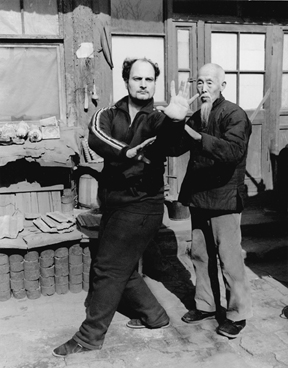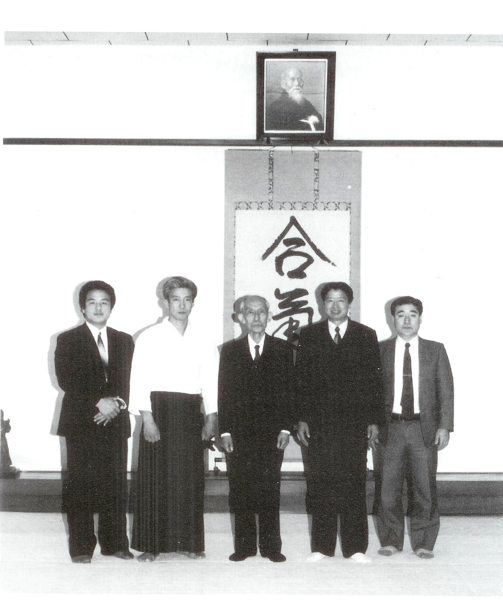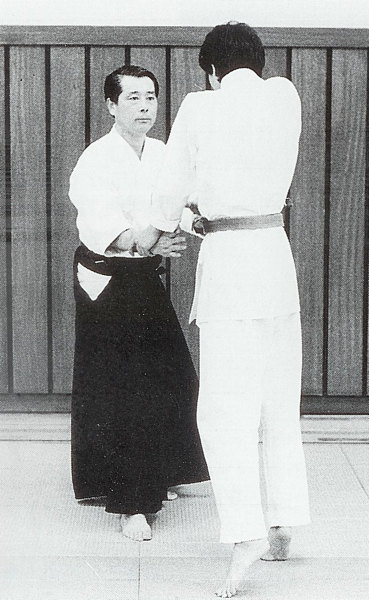Morihei Ueshiba, Bruce Frantzis and Bagua

Bruce Frantzis and Liu Hung Chieh, a master of Bagua, Tai Chi, Hsing-i and Taoist meditation
静中触动动犹静"Seek motion in stillness, seek stillness in motion."The Taiji Classic – "Song of the 13 Postures"動中静、静中動"Stillness in motion, motion in stillness."Seigo Yamaguchi Shihan, Aikido 9th Dan静中の動。合気道の基本は此処に存するといわれている。"Motion in stillness. It is said that here is the foundation of Aikido."Ni-Dai Aikido Doshu Kisshomaru Ueshiba静動一致"The unity of calm and action."(Official English translation – the Kanji read "stillness" and "motion")Ki-Society Founder Koichi Tohei
Bruce Frantzis spent some sixteen years training in China, Japan and India in Tai Chi, Bagua, Hsing-I, Qigong, Yoga and Taoist meditation. From 1967 to 1969 he also trained at Aikikai Hombu Dojo, and was able to attend classes taught by Aikido Founder Morihei Ueshiba. He is the author of a number of books, primarily relating to Chinese Taoist meditational methods and Chinese internal martial arts.
In an article on the Energy Arts website he speaks a little bit about his experiences with O-Sensei, and about his theories about the sources behind O-Sensei’s unusual strength.
"I studied with O-Sensei Morihei Ueshiba, the founder of aikido, during my undergraduate days in Japan. My research has indicated that O-Sensei’s aikido was in a primary way directly influenced by bagua zhang. My first in-depth, extended experience with a top-level master of internal martial arts was with Ueshiba between 1967 and 1969."
It’s quite interesting that Frantzis unequivocally places Morihei Ueshiba in the same category as the Chinese internal martial arts instructors that he trained under.
He’s not alone – in the diagram in this article Keisetsu Yoshimaru directly equates the Kokyu Ryoku (呼吸力 / "breath power") used in Daito-ryu with the explosive power expressed in the Chinese internal martial arts.
However, that very assertion by Yoshimaru (a Daito-ryu practitioner), which shows internal power coming directly to Daito-ryu from Sokaku Takeda without a detour through O-Sensei, shows the difficulty in arguing that the source for O-Sensei’s unusual power was direct instruction in a Chinese internal martial art. It becomes even more difficult when considering that there were a number of people in Daito-ryu, such as Kodo Horikawa and Yukiyoshi Sagawa, who had no real connection to O-Sensei but were able to duplicate his feats of martial prowess.
The common thread, of course, being Sokaku Takeda.(On a related note, you may be interested in this very interesting study by John Driscoll, originally published on AikiWeb, that shows the almost exact correlation between the techniques taught by Morihei Ueshiba and the techniques of the Daito-ryu Hiden Mokuroku.)
I’d go further to debunk the notion of Morihei Ueshiba as a direct student of the Chinese internal martial arts, but it’s already been done – Ellis Amdur covers this topic in some detail in "Hidden in Plain Sight". If you haven’t read it yet then I suggest you make it your next stop for more information about Chinese influences on Japanese martial arts and internal martial arts training in Japanese martial traditions.Stan Pranin also addressed this issue in a recent article on the Aikido Journal website, in which he shows that the argument made by Bruce Frantzis is not historically demonstrable based on what is now known about Morihei Ueshiba’s life. All of which I agree with.But there is a separate discussion here, the issue of a historical Chinese influence on Japanese martial arts in general, and on the arts that Morihei Ueshiba studied in particular, that is not addressed in Stan’s article.
In this respect the sub-title of Stan’s article (“Proponents of the theory of Aikido’s Chinese origin must provide proof.”) is somewhat misleading.


